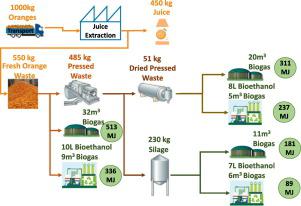Journal of Water Process Engineering ( IF 6.3 ) Pub Date : 2022-07-31 , DOI: 10.1016/j.jwpe.2022.103028 Andreas Christofi , Dionysis Tsipiras , Dimitris Malamis , Konstantinos Moustakas , Sofia Mai , Elli Maria Barampouti

|
The orange juice industry is a dynamic food industrial sector that produces large amounts of waste given that more than half of the processed fruit ends up as waste. In order to reduce its environmental impact, it is usually used as animal feedstuff, either as it is (fresh orange waste) or dehydrated (pressed orange waste) or as silage. In an effort to meet the EU circularity goals, these three possible raw materials were assessed as feedstocks for biogas and/or bioethanol production. Fresh orange waste could provide the highest energy yield via anaerobic digestion (32 m3 biogas/tn orange processed), while the pressed orange waste and silage resulted in the production of 20 and 11 m3 biogas/tn orange processed respectively. The coupling of enzymatic hydrolysis (with 50 μL CellicCTec2/g cellulose) and ethanolic fermentation (with 2 % w/w Saccharomyces cerevisiae) with biogas production for fresh orange waste resulted in the production of 336 MJ/tn orange processed. Conclusively, orange juice industry could meet the EU sustainability goals via valorisation of its waste.
中文翻译:

在循环经济愿景中利用橙汁工业废料生产生物燃料
橙汁行业是一个充满活力的食品工业部门,由于超过一半的加工水果最终成为废物,因此会产生大量废物。为了减少其对环境的影响,它通常被用作动物饲料,无论是原状(新鲜橙废料)或脱水(压榨橙废料)或青贮饲料。为了达到欧盟循环目标,这三种可能的原材料被评估为沼气和/或生物乙醇生产的原料。新鲜橙废料通过厌氧消化可以提供最高的能量产量(32 m 3 沼气/tn 处理的橙子),而压榨的橙子废料和青贮饲料分别产生 20 和 11 m 3沼气/tn 处理的橙子。酶解偶联(用 50 μL CellicCTec2 /g 纤维素)和乙醇发酵(含 2 % w /w酿酒酵母)和沼气生产新鲜橙废料,可生产 336 MJ/tn 处理的橙。总而言之,橙汁行业可以通过对其废物进行增值来实现欧盟的可持续发展目标。











































 京公网安备 11010802027423号
京公网安备 11010802027423号